C228 V3: Sentinel City Health Needs Assessment Report
VerifiedAdded on 2021/04/19
|11
|3009
|303
Report
AI Summary
This report presents a comprehensive health needs assessment of Sentinel City, analyzing demographic data, neighborhood safety, and available community resources. The assessment utilizes various tools, including demographic surveys, neighborhood safety evaluations, scavenger hunts, and windshield surveys, to gather data on the city's population, living conditions, and health concerns. The analysis reveals significant health challenges, including high rates of cardiovascular disease, substance abuse, gang violence, and issues related to lack of recreational facilities. The report identifies three key problem areas: drug and substance abuse, gang violence, and insufficient recreation facilities. It then discusses the scarcity of community resources to address these issues effectively. The report concludes by highlighting the importance of primary prevention strategies, particularly focusing on enhancing cardiovascular health through education and promotion of healthy lifestyles. It also outlines the application of assessment strategies, emphasizing the need for stakeholder engagement, community knowledge, data collection, and communication to address health concerns effectively. The assessment strategies are applied between the simulation and the community to find the best results.
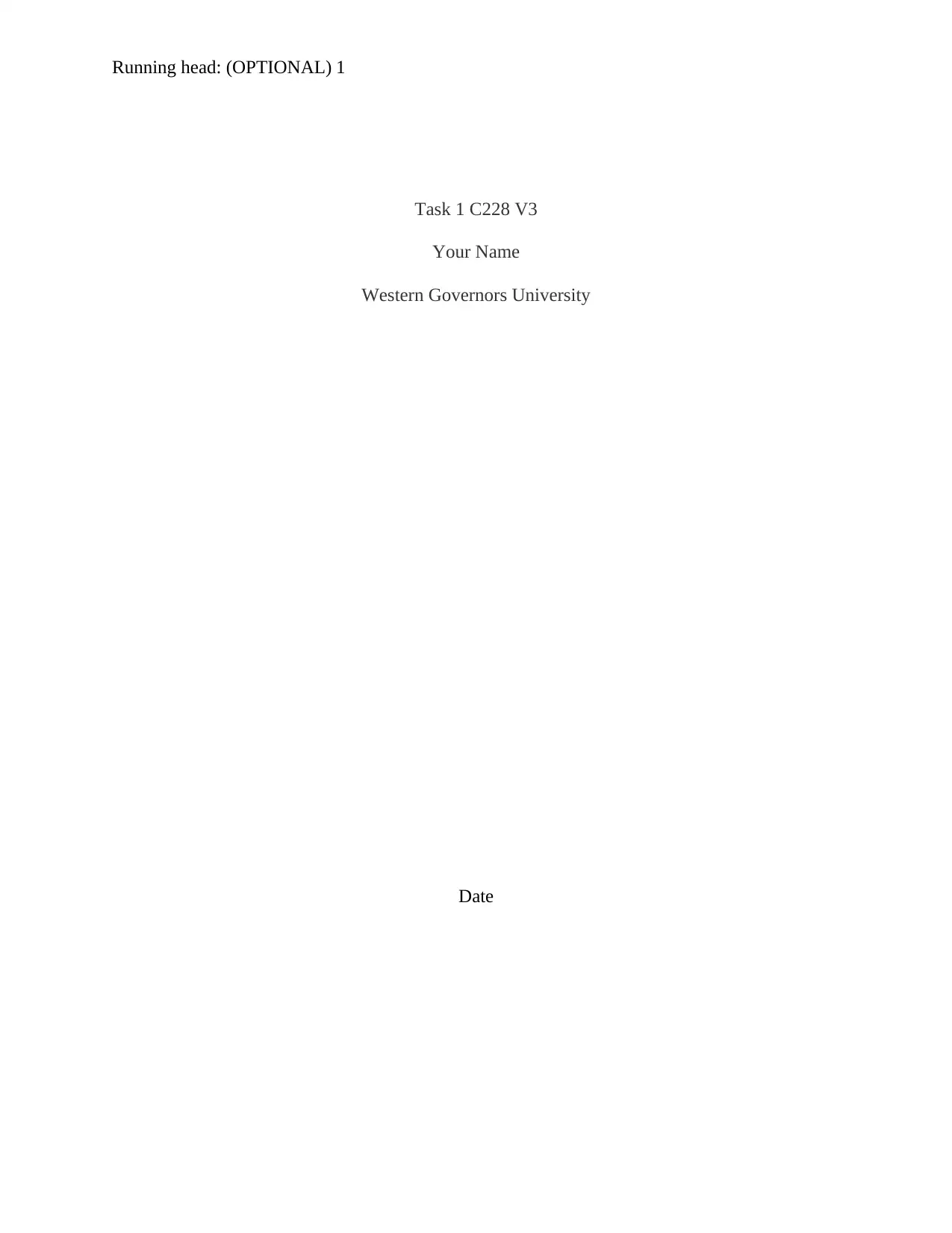
Running head: (OPTIONAL) 1
Task 1 C228 V3
Your Name
Western Governors University
Date
Task 1 C228 V3
Your Name
Western Governors University
Date
Paraphrase This Document
Need a fresh take? Get an instant paraphrase of this document with our AI Paraphraser
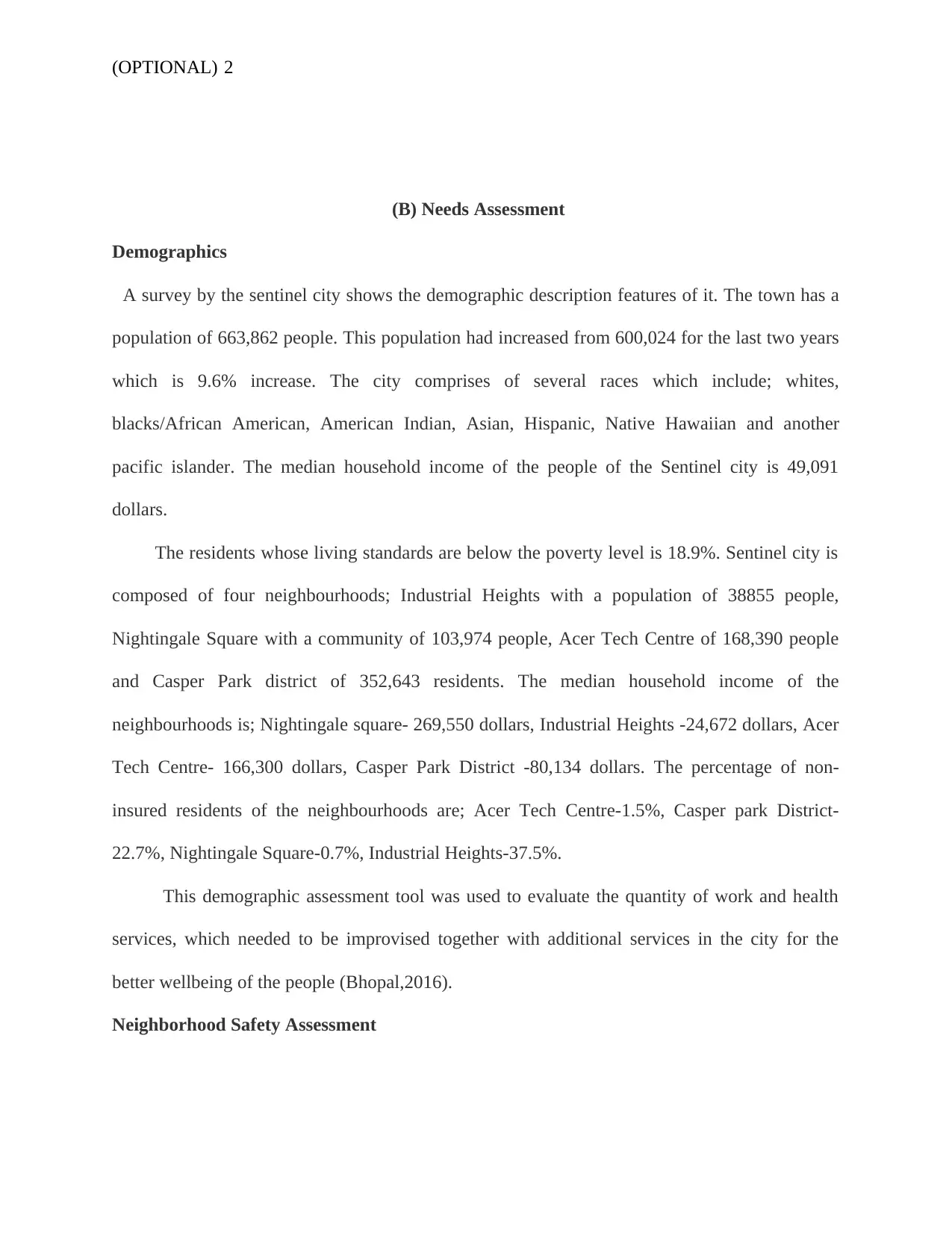
(OPTIONAL) 2
(B) Needs Assessment
Demographics
A survey by the sentinel city shows the demographic description features of it. The town has a
population of 663,862 people. This population had increased from 600,024 for the last two years
which is 9.6% increase. The city comprises of several races which include; whites,
blacks/African American, American Indian, Asian, Hispanic, Native Hawaiian and another
pacific islander. The median household income of the people of the Sentinel city is 49,091
dollars.
The residents whose living standards are below the poverty level is 18.9%. Sentinel city is
composed of four neighbourhoods; Industrial Heights with a population of 38855 people,
Nightingale Square with a community of 103,974 people, Acer Tech Centre of 168,390 people
and Casper Park district of 352,643 residents. The median household income of the
neighbourhoods is; Nightingale square- 269,550 dollars, Industrial Heights -24,672 dollars, Acer
Tech Centre- 166,300 dollars, Casper Park District -80,134 dollars. The percentage of non-
insured residents of the neighbourhoods are; Acer Tech Centre-1.5%, Casper park District-
22.7%, Nightingale Square-0.7%, Industrial Heights-37.5%.
This demographic assessment tool was used to evaluate the quantity of work and health
services, which needed to be improvised together with additional services in the city for the
better wellbeing of the people (Bhopal,2016).
Neighborhood Safety Assessment
(B) Needs Assessment
Demographics
A survey by the sentinel city shows the demographic description features of it. The town has a
population of 663,862 people. This population had increased from 600,024 for the last two years
which is 9.6% increase. The city comprises of several races which include; whites,
blacks/African American, American Indian, Asian, Hispanic, Native Hawaiian and another
pacific islander. The median household income of the people of the Sentinel city is 49,091
dollars.
The residents whose living standards are below the poverty level is 18.9%. Sentinel city is
composed of four neighbourhoods; Industrial Heights with a population of 38855 people,
Nightingale Square with a community of 103,974 people, Acer Tech Centre of 168,390 people
and Casper Park district of 352,643 residents. The median household income of the
neighbourhoods is; Nightingale square- 269,550 dollars, Industrial Heights -24,672 dollars, Acer
Tech Centre- 166,300 dollars, Casper Park District -80,134 dollars. The percentage of non-
insured residents of the neighbourhoods are; Acer Tech Centre-1.5%, Casper park District-
22.7%, Nightingale Square-0.7%, Industrial Heights-37.5%.
This demographic assessment tool was used to evaluate the quantity of work and health
services, which needed to be improvised together with additional services in the city for the
better wellbeing of the people (Bhopal,2016).
Neighborhood Safety Assessment
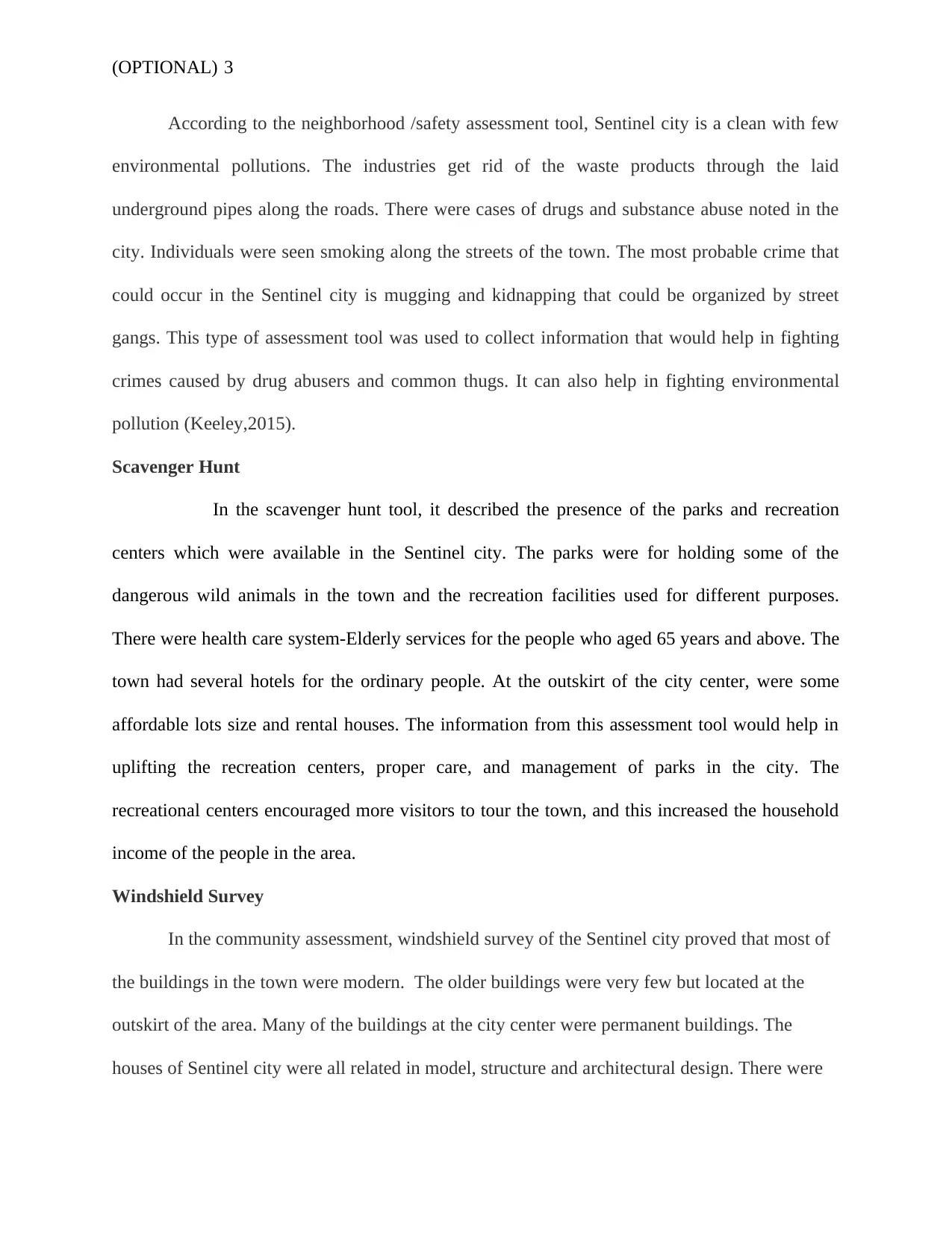
(OPTIONAL) 3
According to the neighborhood /safety assessment tool, Sentinel city is a clean with few
environmental pollutions. The industries get rid of the waste products through the laid
underground pipes along the roads. There were cases of drugs and substance abuse noted in the
city. Individuals were seen smoking along the streets of the town. The most probable crime that
could occur in the Sentinel city is mugging and kidnapping that could be organized by street
gangs. This type of assessment tool was used to collect information that would help in fighting
crimes caused by drug abusers and common thugs. It can also help in fighting environmental
pollution (Keeley,2015).
Scavenger Hunt
In the scavenger hunt tool, it described the presence of the parks and recreation
centers which were available in the Sentinel city. The parks were for holding some of the
dangerous wild animals in the town and the recreation facilities used for different purposes.
There were health care system-Elderly services for the people who aged 65 years and above. The
town had several hotels for the ordinary people. At the outskirt of the city center, were some
affordable lots size and rental houses. The information from this assessment tool would help in
uplifting the recreation centers, proper care, and management of parks in the city. The
recreational centers encouraged more visitors to tour the town, and this increased the household
income of the people in the area.
Windshield Survey
In the community assessment, windshield survey of the Sentinel city proved that most of
the buildings in the town were modern. The older buildings were very few but located at the
outskirt of the area. Many of the buildings at the city center were permanent buildings. The
houses of Sentinel city were all related in model, structure and architectural design. There were
According to the neighborhood /safety assessment tool, Sentinel city is a clean with few
environmental pollutions. The industries get rid of the waste products through the laid
underground pipes along the roads. There were cases of drugs and substance abuse noted in the
city. Individuals were seen smoking along the streets of the town. The most probable crime that
could occur in the Sentinel city is mugging and kidnapping that could be organized by street
gangs. This type of assessment tool was used to collect information that would help in fighting
crimes caused by drug abusers and common thugs. It can also help in fighting environmental
pollution (Keeley,2015).
Scavenger Hunt
In the scavenger hunt tool, it described the presence of the parks and recreation
centers which were available in the Sentinel city. The parks were for holding some of the
dangerous wild animals in the town and the recreation facilities used for different purposes.
There were health care system-Elderly services for the people who aged 65 years and above. The
town had several hotels for the ordinary people. At the outskirt of the city center, were some
affordable lots size and rental houses. The information from this assessment tool would help in
uplifting the recreation centers, proper care, and management of parks in the city. The
recreational centers encouraged more visitors to tour the town, and this increased the household
income of the people in the area.
Windshield Survey
In the community assessment, windshield survey of the Sentinel city proved that most of
the buildings in the town were modern. The older buildings were very few but located at the
outskirt of the area. Many of the buildings at the city center were permanent buildings. The
houses of Sentinel city were all related in model, structure and architectural design. There were
⊘ This is a preview!⊘
Do you want full access?
Subscribe today to unlock all pages.

Trusted by 1+ million students worldwide
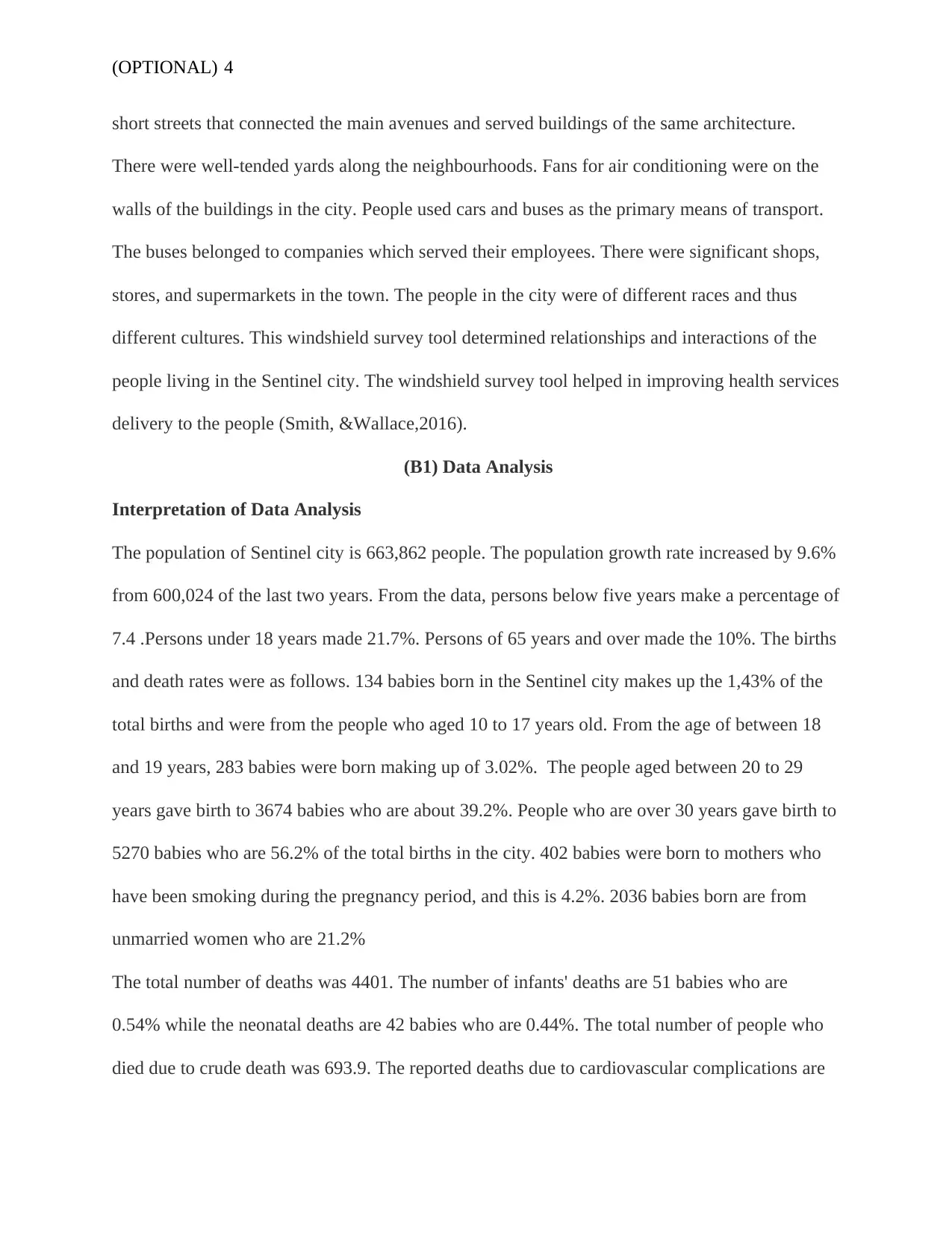
(OPTIONAL) 4
short streets that connected the main avenues and served buildings of the same architecture.
There were well-tended yards along the neighbourhoods. Fans for air conditioning were on the
walls of the buildings in the city. People used cars and buses as the primary means of transport.
The buses belonged to companies which served their employees. There were significant shops,
stores, and supermarkets in the town. The people in the city were of different races and thus
different cultures. This windshield survey tool determined relationships and interactions of the
people living in the Sentinel city. The windshield survey tool helped in improving health services
delivery to the people (Smith, &Wallace,2016).
(B1) Data Analysis
Interpretation of Data Analysis
The population of Sentinel city is 663,862 people. The population growth rate increased by 9.6%
from 600,024 of the last two years. From the data, persons below five years make a percentage of
7.4 .Persons under 18 years made 21.7%. Persons of 65 years and over made the 10%. The births
and death rates were as follows. 134 babies born in the Sentinel city makes up the 1,43% of the
total births and were from the people who aged 10 to 17 years old. From the age of between 18
and 19 years, 283 babies were born making up of 3.02%. The people aged between 20 to 29
years gave birth to 3674 babies who are about 39.2%. People who are over 30 years gave birth to
5270 babies who are 56.2% of the total births in the city. 402 babies were born to mothers who
have been smoking during the pregnancy period, and this is 4.2%. 2036 babies born are from
unmarried women who are 21.2%
The total number of deaths was 4401. The number of infants' deaths are 51 babies who are
0.54% while the neonatal deaths are 42 babies who are 0.44%. The total number of people who
died due to crude death was 693.9. The reported deaths due to cardiovascular complications are
short streets that connected the main avenues and served buildings of the same architecture.
There were well-tended yards along the neighbourhoods. Fans for air conditioning were on the
walls of the buildings in the city. People used cars and buses as the primary means of transport.
The buses belonged to companies which served their employees. There were significant shops,
stores, and supermarkets in the town. The people in the city were of different races and thus
different cultures. This windshield survey tool determined relationships and interactions of the
people living in the Sentinel city. The windshield survey tool helped in improving health services
delivery to the people (Smith, &Wallace,2016).
(B1) Data Analysis
Interpretation of Data Analysis
The population of Sentinel city is 663,862 people. The population growth rate increased by 9.6%
from 600,024 of the last two years. From the data, persons below five years make a percentage of
7.4 .Persons under 18 years made 21.7%. Persons of 65 years and over made the 10%. The births
and death rates were as follows. 134 babies born in the Sentinel city makes up the 1,43% of the
total births and were from the people who aged 10 to 17 years old. From the age of between 18
and 19 years, 283 babies were born making up of 3.02%. The people aged between 20 to 29
years gave birth to 3674 babies who are about 39.2%. People who are over 30 years gave birth to
5270 babies who are 56.2% of the total births in the city. 402 babies were born to mothers who
have been smoking during the pregnancy period, and this is 4.2%. 2036 babies born are from
unmarried women who are 21.2%
The total number of deaths was 4401. The number of infants' deaths are 51 babies who are
0.54% while the neonatal deaths are 42 babies who are 0.44%. The total number of people who
died due to crude death was 693.9. The reported deaths due to cardiovascular complications are
Paraphrase This Document
Need a fresh take? Get an instant paraphrase of this document with our AI Paraphraser
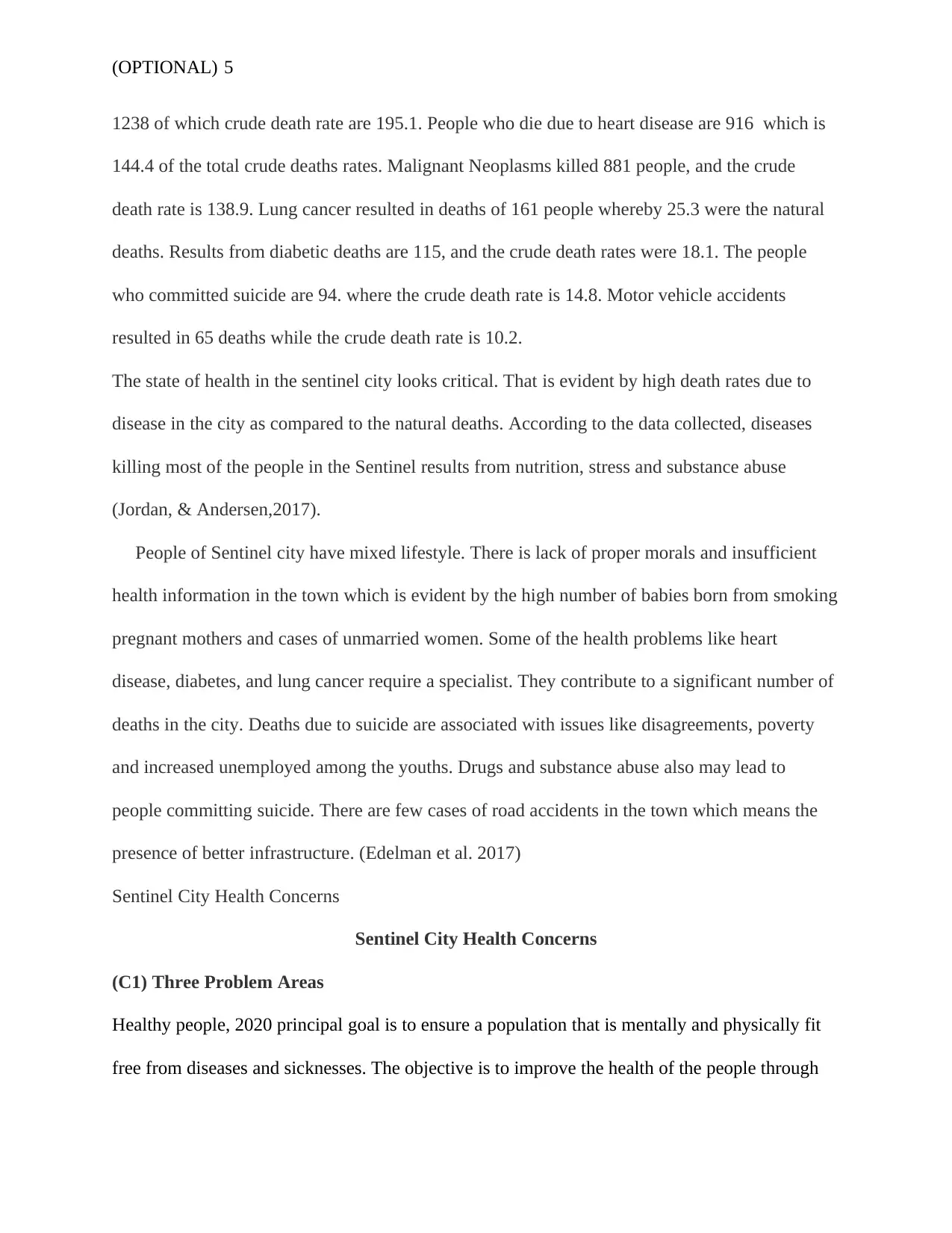
(OPTIONAL) 5
1238 of which crude death rate are 195.1. People who die due to heart disease are 916 which is
144.4 of the total crude deaths rates. Malignant Neoplasms killed 881 people, and the crude
death rate is 138.9. Lung cancer resulted in deaths of 161 people whereby 25.3 were the natural
deaths. Results from diabetic deaths are 115, and the crude death rates were 18.1. The people
who committed suicide are 94. where the crude death rate is 14.8. Motor vehicle accidents
resulted in 65 deaths while the crude death rate is 10.2.
The state of health in the sentinel city looks critical. That is evident by high death rates due to
disease in the city as compared to the natural deaths. According to the data collected, diseases
killing most of the people in the Sentinel results from nutrition, stress and substance abuse
(Jordan, & Andersen,2017).
People of Sentinel city have mixed lifestyle. There is lack of proper morals and insufficient
health information in the town which is evident by the high number of babies born from smoking
pregnant mothers and cases of unmarried women. Some of the health problems like heart
disease, diabetes, and lung cancer require a specialist. They contribute to a significant number of
deaths in the city. Deaths due to suicide are associated with issues like disagreements, poverty
and increased unemployed among the youths. Drugs and substance abuse also may lead to
people committing suicide. There are few cases of road accidents in the town which means the
presence of better infrastructure. (Edelman et al. 2017)
Sentinel City Health Concerns
Sentinel City Health Concerns
(C1) Three Problem Areas
Healthy people, 2020 principal goal is to ensure a population that is mentally and physically fit
free from diseases and sicknesses. The objective is to improve the health of the people through
1238 of which crude death rate are 195.1. People who die due to heart disease are 916 which is
144.4 of the total crude deaths rates. Malignant Neoplasms killed 881 people, and the crude
death rate is 138.9. Lung cancer resulted in deaths of 161 people whereby 25.3 were the natural
deaths. Results from diabetic deaths are 115, and the crude death rates were 18.1. The people
who committed suicide are 94. where the crude death rate is 14.8. Motor vehicle accidents
resulted in 65 deaths while the crude death rate is 10.2.
The state of health in the sentinel city looks critical. That is evident by high death rates due to
disease in the city as compared to the natural deaths. According to the data collected, diseases
killing most of the people in the Sentinel results from nutrition, stress and substance abuse
(Jordan, & Andersen,2017).
People of Sentinel city have mixed lifestyle. There is lack of proper morals and insufficient
health information in the town which is evident by the high number of babies born from smoking
pregnant mothers and cases of unmarried women. Some of the health problems like heart
disease, diabetes, and lung cancer require a specialist. They contribute to a significant number of
deaths in the city. Deaths due to suicide are associated with issues like disagreements, poverty
and increased unemployed among the youths. Drugs and substance abuse also may lead to
people committing suicide. There are few cases of road accidents in the town which means the
presence of better infrastructure. (Edelman et al. 2017)
Sentinel City Health Concerns
Sentinel City Health Concerns
(C1) Three Problem Areas
Healthy people, 2020 principal goal is to ensure a population that is mentally and physically fit
free from diseases and sicknesses. The objective is to improve the health of the people through
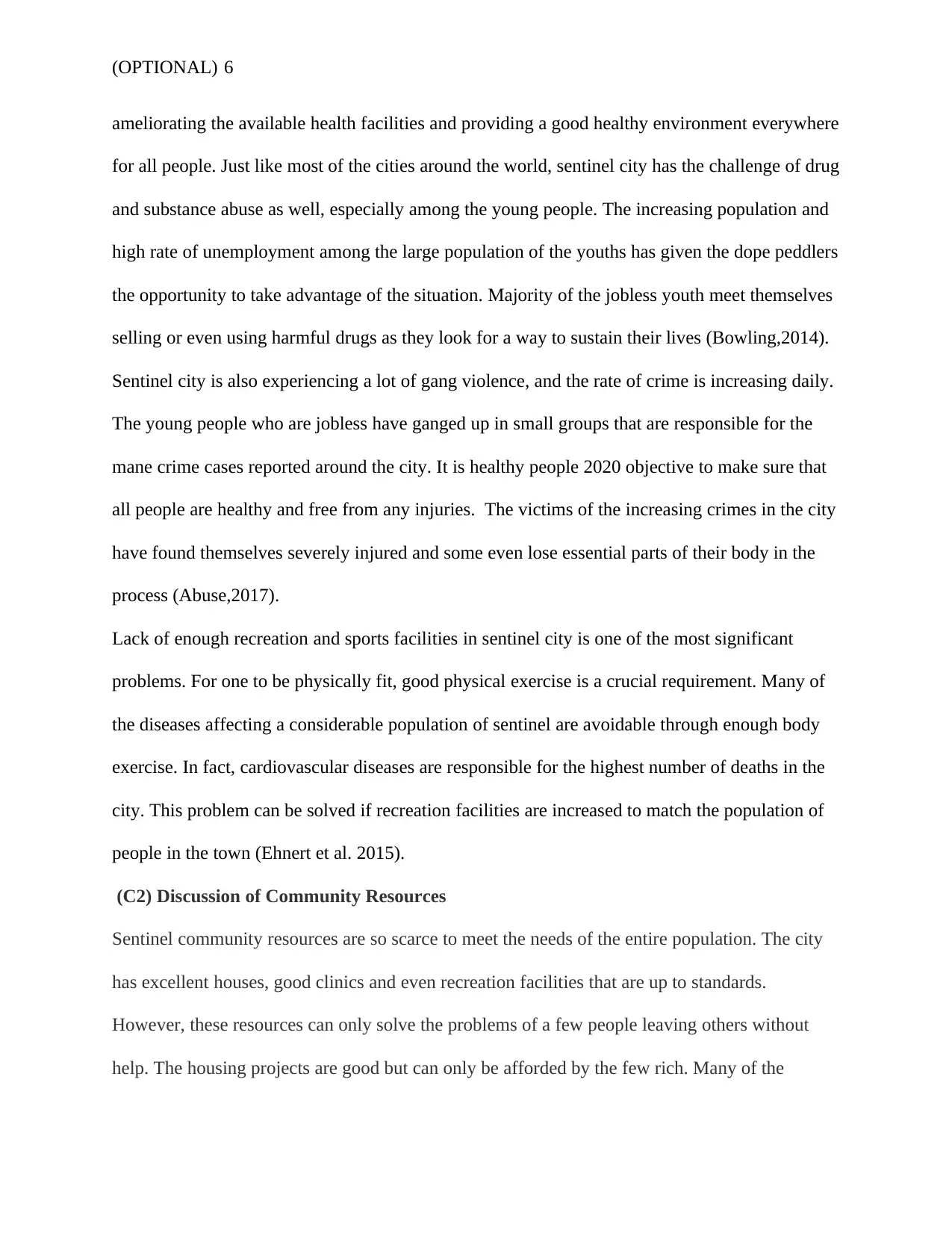
(OPTIONAL) 6
ameliorating the available health facilities and providing a good healthy environment everywhere
for all people. Just like most of the cities around the world, sentinel city has the challenge of drug
and substance abuse as well, especially among the young people. The increasing population and
high rate of unemployment among the large population of the youths has given the dope peddlers
the opportunity to take advantage of the situation. Majority of the jobless youth meet themselves
selling or even using harmful drugs as they look for a way to sustain their lives (Bowling,2014).
Sentinel city is also experiencing a lot of gang violence, and the rate of crime is increasing daily.
The young people who are jobless have ganged up in small groups that are responsible for the
mane crime cases reported around the city. It is healthy people 2020 objective to make sure that
all people are healthy and free from any injuries. The victims of the increasing crimes in the city
have found themselves severely injured and some even lose essential parts of their body in the
process (Abuse,2017).
Lack of enough recreation and sports facilities in sentinel city is one of the most significant
problems. For one to be physically fit, good physical exercise is a crucial requirement. Many of
the diseases affecting a considerable population of sentinel are avoidable through enough body
exercise. In fact, cardiovascular diseases are responsible for the highest number of deaths in the
city. This problem can be solved if recreation facilities are increased to match the population of
people in the town (Ehnert et al. 2015).
(C2) Discussion of Community Resources
Sentinel community resources are so scarce to meet the needs of the entire population. The city
has excellent houses, good clinics and even recreation facilities that are up to standards.
However, these resources can only solve the problems of a few people leaving others without
help. The housing projects are good but can only be afforded by the few rich. Many of the
ameliorating the available health facilities and providing a good healthy environment everywhere
for all people. Just like most of the cities around the world, sentinel city has the challenge of drug
and substance abuse as well, especially among the young people. The increasing population and
high rate of unemployment among the large population of the youths has given the dope peddlers
the opportunity to take advantage of the situation. Majority of the jobless youth meet themselves
selling or even using harmful drugs as they look for a way to sustain their lives (Bowling,2014).
Sentinel city is also experiencing a lot of gang violence, and the rate of crime is increasing daily.
The young people who are jobless have ganged up in small groups that are responsible for the
mane crime cases reported around the city. It is healthy people 2020 objective to make sure that
all people are healthy and free from any injuries. The victims of the increasing crimes in the city
have found themselves severely injured and some even lose essential parts of their body in the
process (Abuse,2017).
Lack of enough recreation and sports facilities in sentinel city is one of the most significant
problems. For one to be physically fit, good physical exercise is a crucial requirement. Many of
the diseases affecting a considerable population of sentinel are avoidable through enough body
exercise. In fact, cardiovascular diseases are responsible for the highest number of deaths in the
city. This problem can be solved if recreation facilities are increased to match the population of
people in the town (Ehnert et al. 2015).
(C2) Discussion of Community Resources
Sentinel community resources are so scarce to meet the needs of the entire population. The city
has excellent houses, good clinics and even recreation facilities that are up to standards.
However, these resources can only solve the problems of a few people leaving others without
help. The housing projects are good but can only be afforded by the few rich. Many of the
⊘ This is a preview!⊘
Do you want full access?
Subscribe today to unlock all pages.

Trusted by 1+ million students worldwide
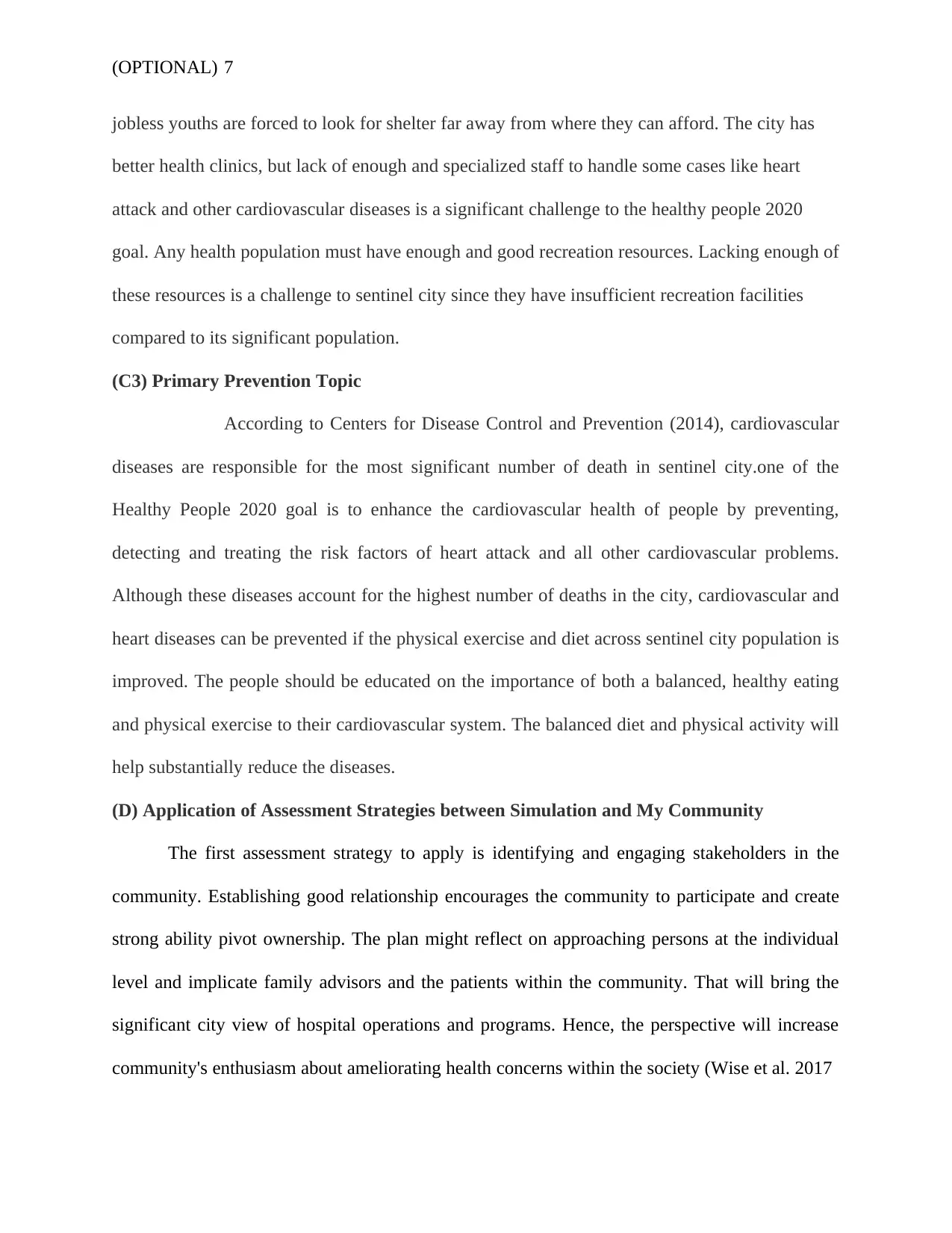
(OPTIONAL) 7
jobless youths are forced to look for shelter far away from where they can afford. The city has
better health clinics, but lack of enough and specialized staff to handle some cases like heart
attack and other cardiovascular diseases is a significant challenge to the healthy people 2020
goal. Any health population must have enough and good recreation resources. Lacking enough of
these resources is a challenge to sentinel city since they have insufficient recreation facilities
compared to its significant population.
(C3) Primary Prevention Topic
According to Centers for Disease Control and Prevention (2014), cardiovascular
diseases are responsible for the most significant number of death in sentinel city.one of the
Healthy People 2020 goal is to enhance the cardiovascular health of people by preventing,
detecting and treating the risk factors of heart attack and all other cardiovascular problems.
Although these diseases account for the highest number of deaths in the city, cardiovascular and
heart diseases can be prevented if the physical exercise and diet across sentinel city population is
improved. The people should be educated on the importance of both a balanced, healthy eating
and physical exercise to their cardiovascular system. The balanced diet and physical activity will
help substantially reduce the diseases.
(D) Application of Assessment Strategies between Simulation and My Community
The first assessment strategy to apply is identifying and engaging stakeholders in the
community. Establishing good relationship encourages the community to participate and create
strong ability pivot ownership. The plan might reflect on approaching persons at the individual
level and implicate family advisors and the patients within the community. That will bring the
significant city view of hospital operations and programs. Hence, the perspective will increase
community's enthusiasm about ameliorating health concerns within the society (Wise et al. 2017
jobless youths are forced to look for shelter far away from where they can afford. The city has
better health clinics, but lack of enough and specialized staff to handle some cases like heart
attack and other cardiovascular diseases is a significant challenge to the healthy people 2020
goal. Any health population must have enough and good recreation resources. Lacking enough of
these resources is a challenge to sentinel city since they have insufficient recreation facilities
compared to its significant population.
(C3) Primary Prevention Topic
According to Centers for Disease Control and Prevention (2014), cardiovascular
diseases are responsible for the most significant number of death in sentinel city.one of the
Healthy People 2020 goal is to enhance the cardiovascular health of people by preventing,
detecting and treating the risk factors of heart attack and all other cardiovascular problems.
Although these diseases account for the highest number of deaths in the city, cardiovascular and
heart diseases can be prevented if the physical exercise and diet across sentinel city population is
improved. The people should be educated on the importance of both a balanced, healthy eating
and physical exercise to their cardiovascular system. The balanced diet and physical activity will
help substantially reduce the diseases.
(D) Application of Assessment Strategies between Simulation and My Community
The first assessment strategy to apply is identifying and engaging stakeholders in the
community. Establishing good relationship encourages the community to participate and create
strong ability pivot ownership. The plan might reflect on approaching persons at the individual
level and implicate family advisors and the patients within the community. That will bring the
significant city view of hospital operations and programs. Hence, the perspective will increase
community's enthusiasm about ameliorating health concerns within the society (Wise et al. 2017
Paraphrase This Document
Need a fresh take? Get an instant paraphrase of this document with our AI Paraphraser
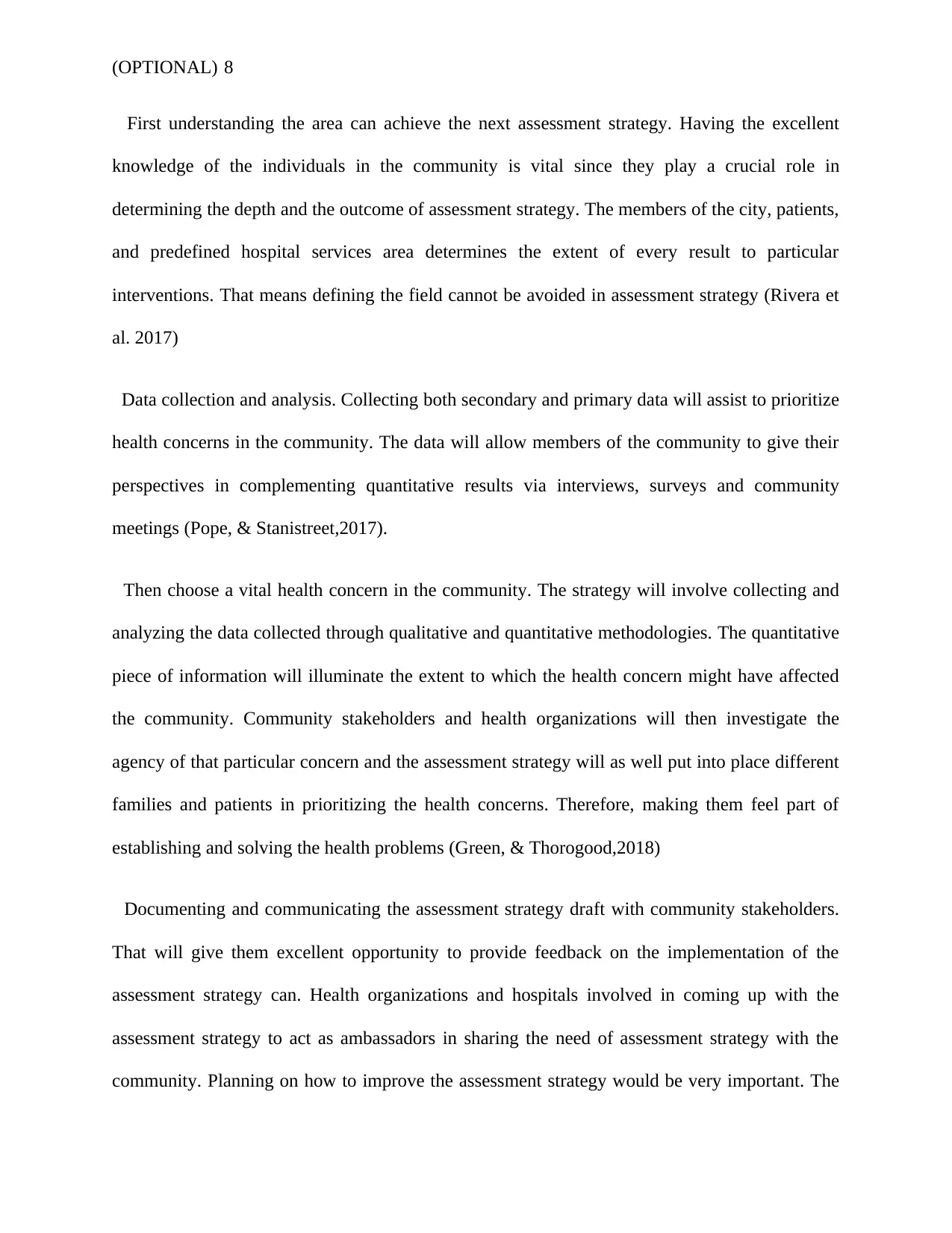
(OPTIONAL) 8
First understanding the area can achieve the next assessment strategy. Having the excellent
knowledge of the individuals in the community is vital since they play a crucial role in
determining the depth and the outcome of assessment strategy. The members of the city, patients,
and predefined hospital services area determines the extent of every result to particular
interventions. That means defining the field cannot be avoided in assessment strategy (Rivera et
al. 2017)
Data collection and analysis. Collecting both secondary and primary data will assist to prioritize
health concerns in the community. The data will allow members of the community to give their
perspectives in complementing quantitative results via interviews, surveys and community
meetings (Pope, & Stanistreet,2017).
Then choose a vital health concern in the community. The strategy will involve collecting and
analyzing the data collected through qualitative and quantitative methodologies. The quantitative
piece of information will illuminate the extent to which the health concern might have affected
the community. Community stakeholders and health organizations will then investigate the
agency of that particular concern and the assessment strategy will as well put into place different
families and patients in prioritizing the health concerns. Therefore, making them feel part of
establishing and solving the health problems (Green, & Thorogood,2018)
Documenting and communicating the assessment strategy draft with community stakeholders.
That will give them excellent opportunity to provide feedback on the implementation of the
assessment strategy can. Health organizations and hospitals involved in coming up with the
assessment strategy to act as ambassadors in sharing the need of assessment strategy with the
community. Planning on how to improve the assessment strategy would be very important. The
First understanding the area can achieve the next assessment strategy. Having the excellent
knowledge of the individuals in the community is vital since they play a crucial role in
determining the depth and the outcome of assessment strategy. The members of the city, patients,
and predefined hospital services area determines the extent of every result to particular
interventions. That means defining the field cannot be avoided in assessment strategy (Rivera et
al. 2017)
Data collection and analysis. Collecting both secondary and primary data will assist to prioritize
health concerns in the community. The data will allow members of the community to give their
perspectives in complementing quantitative results via interviews, surveys and community
meetings (Pope, & Stanistreet,2017).
Then choose a vital health concern in the community. The strategy will involve collecting and
analyzing the data collected through qualitative and quantitative methodologies. The quantitative
piece of information will illuminate the extent to which the health concern might have affected
the community. Community stakeholders and health organizations will then investigate the
agency of that particular concern and the assessment strategy will as well put into place different
families and patients in prioritizing the health concerns. Therefore, making them feel part of
establishing and solving the health problems (Green, & Thorogood,2018)
Documenting and communicating the assessment strategy draft with community stakeholders.
That will give them excellent opportunity to provide feedback on the implementation of the
assessment strategy can. Health organizations and hospitals involved in coming up with the
assessment strategy to act as ambassadors in sharing the need of assessment strategy with the
community. Planning on how to improve the assessment strategy would be very important. The
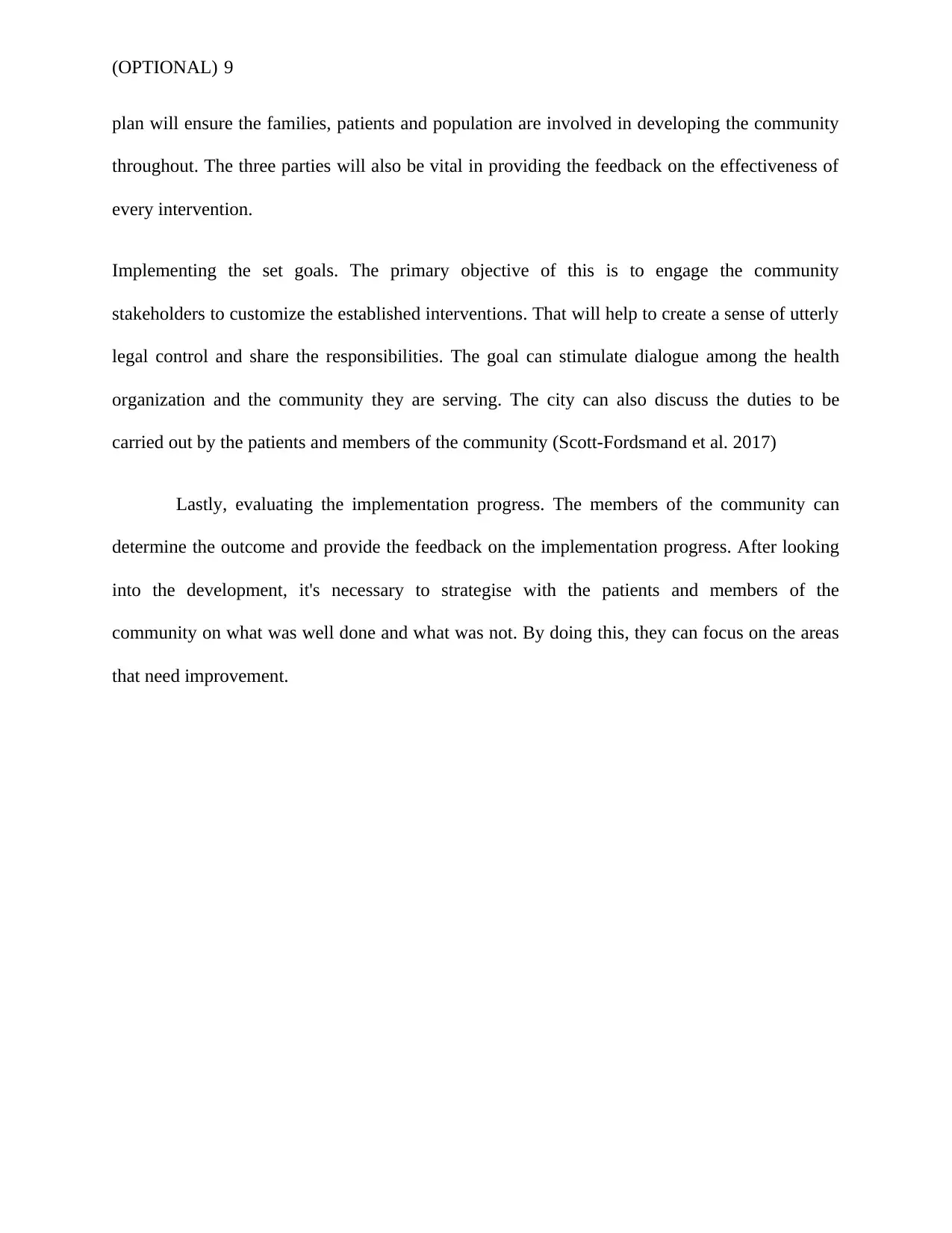
(OPTIONAL) 9
plan will ensure the families, patients and population are involved in developing the community
throughout. The three parties will also be vital in providing the feedback on the effectiveness of
every intervention.
Implementing the set goals. The primary objective of this is to engage the community
stakeholders to customize the established interventions. That will help to create a sense of utterly
legal control and share the responsibilities. The goal can stimulate dialogue among the health
organization and the community they are serving. The city can also discuss the duties to be
carried out by the patients and members of the community (Scott‐Fordsmand et al. 2017)
Lastly, evaluating the implementation progress. The members of the community can
determine the outcome and provide the feedback on the implementation progress. After looking
into the development, it's necessary to strategise with the patients and members of the
community on what was well done and what was not. By doing this, they can focus on the areas
that need improvement.
plan will ensure the families, patients and population are involved in developing the community
throughout. The three parties will also be vital in providing the feedback on the effectiveness of
every intervention.
Implementing the set goals. The primary objective of this is to engage the community
stakeholders to customize the established interventions. That will help to create a sense of utterly
legal control and share the responsibilities. The goal can stimulate dialogue among the health
organization and the community they are serving. The city can also discuss the duties to be
carried out by the patients and members of the community (Scott‐Fordsmand et al. 2017)
Lastly, evaluating the implementation progress. The members of the community can
determine the outcome and provide the feedback on the implementation progress. After looking
into the development, it's necessary to strategise with the patients and members of the
community on what was well done and what was not. By doing this, they can focus on the areas
that need improvement.
⊘ This is a preview!⊘
Do you want full access?
Subscribe today to unlock all pages.

Trusted by 1+ million students worldwide
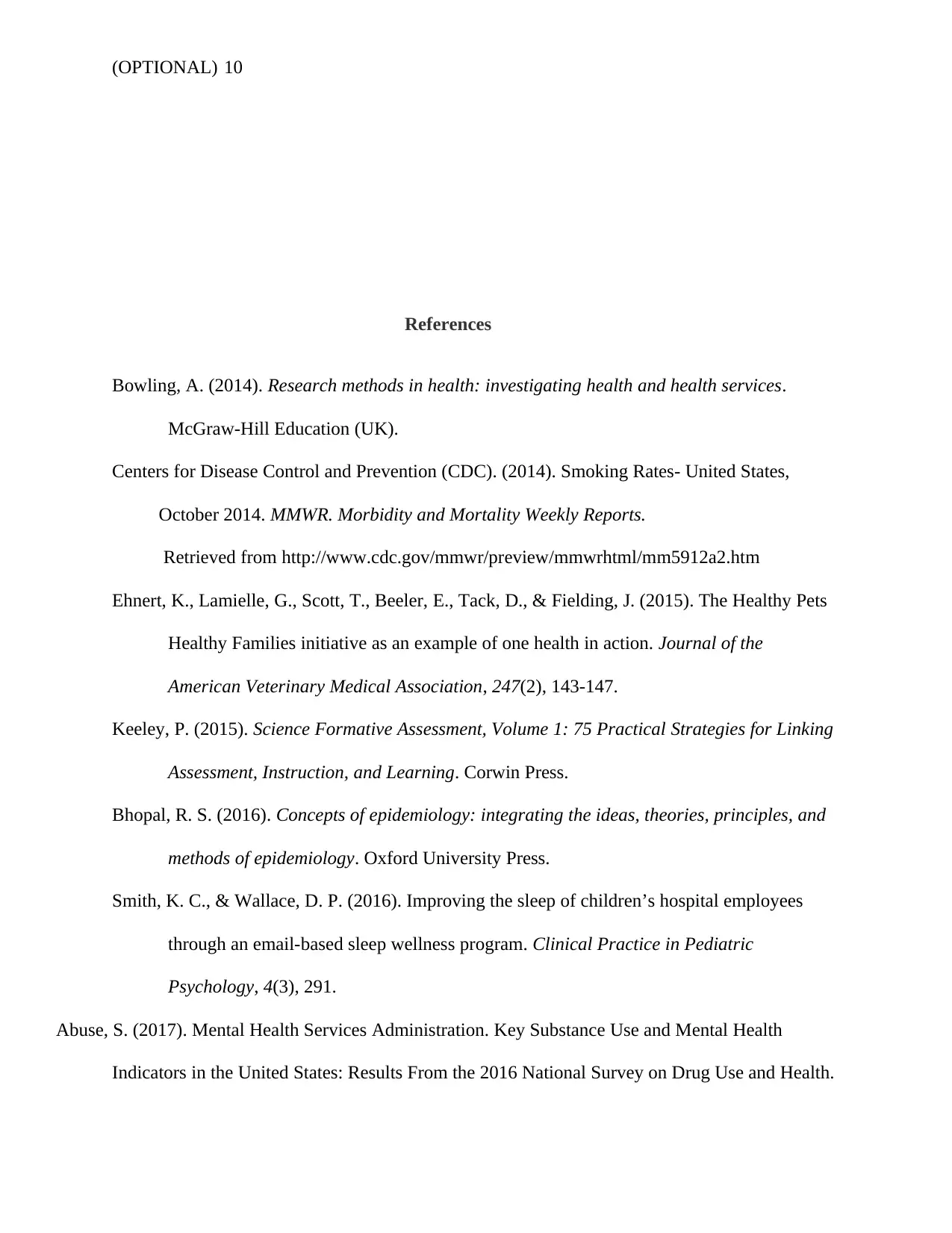
(OPTIONAL) 10
References
Bowling, A. (2014). Research methods in health: investigating health and health services.
McGraw-Hill Education (UK).
Centers for Disease Control and Prevention (CDC). (2014). Smoking Rates- United States,
October 2014. MMWR. Morbidity and Mortality Weekly Reports.
Retrieved from http://www.cdc.gov/mmwr/preview/mmwrhtml/mm5912a2.htm
Ehnert, K., Lamielle, G., Scott, T., Beeler, E., Tack, D., & Fielding, J. (2015). The Healthy Pets
Healthy Families initiative as an example of one health in action. Journal of the
American Veterinary Medical Association, 247(2), 143-147.
Keeley, P. (2015). Science Formative Assessment, Volume 1: 75 Practical Strategies for Linking
Assessment, Instruction, and Learning. Corwin Press.
Bhopal, R. S. (2016). Concepts of epidemiology: integrating the ideas, theories, principles, and
methods of epidemiology. Oxford University Press.
Smith, K. C., & Wallace, D. P. (2016). Improving the sleep of children’s hospital employees
through an email-based sleep wellness program. Clinical Practice in Pediatric
Psychology, 4(3), 291.
Abuse, S. (2017). Mental Health Services Administration. Key Substance Use and Mental Health
Indicators in the United States: Results From the 2016 National Survey on Drug Use and Health.
References
Bowling, A. (2014). Research methods in health: investigating health and health services.
McGraw-Hill Education (UK).
Centers for Disease Control and Prevention (CDC). (2014). Smoking Rates- United States,
October 2014. MMWR. Morbidity and Mortality Weekly Reports.
Retrieved from http://www.cdc.gov/mmwr/preview/mmwrhtml/mm5912a2.htm
Ehnert, K., Lamielle, G., Scott, T., Beeler, E., Tack, D., & Fielding, J. (2015). The Healthy Pets
Healthy Families initiative as an example of one health in action. Journal of the
American Veterinary Medical Association, 247(2), 143-147.
Keeley, P. (2015). Science Formative Assessment, Volume 1: 75 Practical Strategies for Linking
Assessment, Instruction, and Learning. Corwin Press.
Bhopal, R. S. (2016). Concepts of epidemiology: integrating the ideas, theories, principles, and
methods of epidemiology. Oxford University Press.
Smith, K. C., & Wallace, D. P. (2016). Improving the sleep of children’s hospital employees
through an email-based sleep wellness program. Clinical Practice in Pediatric
Psychology, 4(3), 291.
Abuse, S. (2017). Mental Health Services Administration. Key Substance Use and Mental Health
Indicators in the United States: Results From the 2016 National Survey on Drug Use and Health.
Paraphrase This Document
Need a fresh take? Get an instant paraphrase of this document with our AI Paraphraser
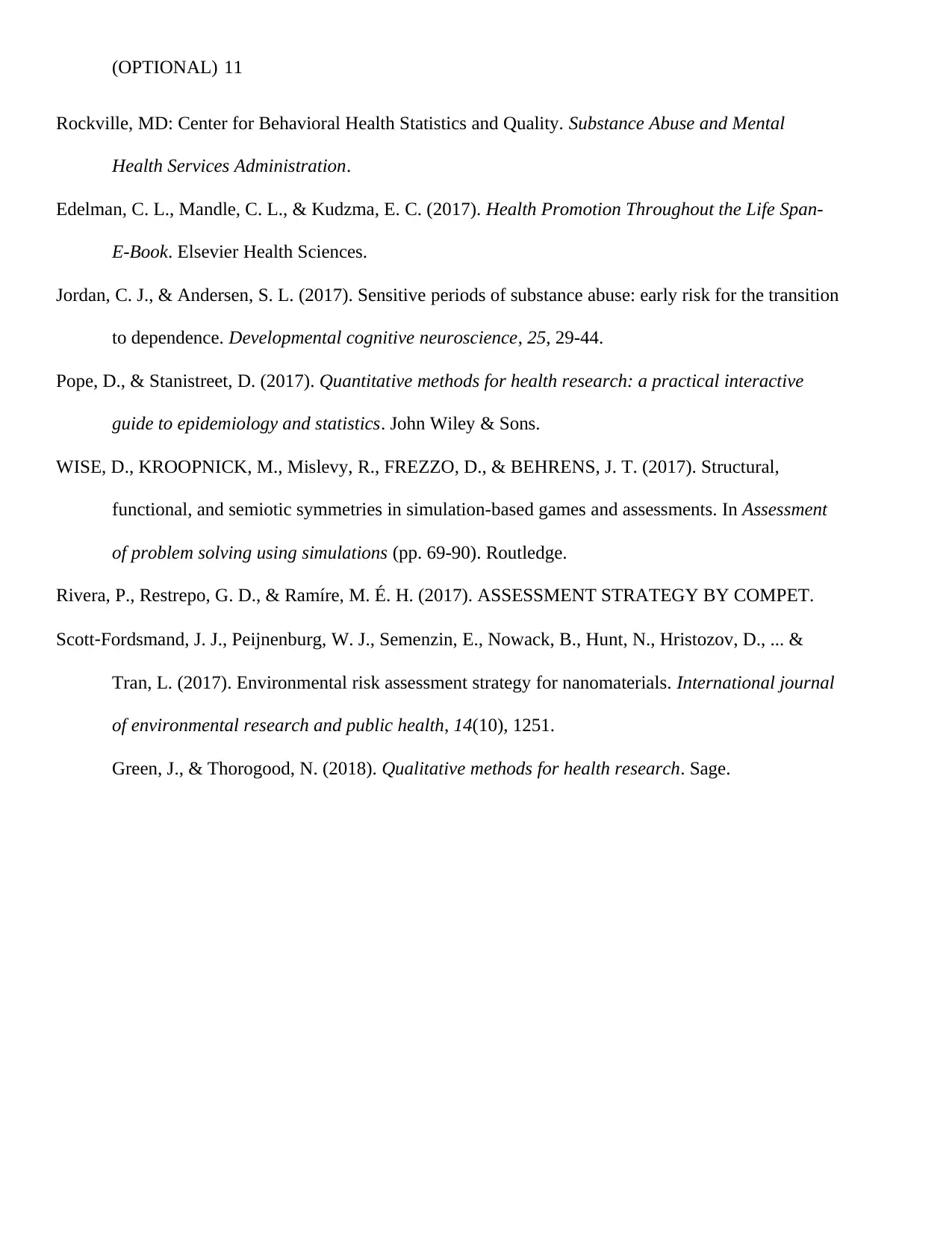
(OPTIONAL) 11
Rockville, MD: Center for Behavioral Health Statistics and Quality. Substance Abuse and Mental
Health Services Administration.
Edelman, C. L., Mandle, C. L., & Kudzma, E. C. (2017). Health Promotion Throughout the Life Span-
E-Book. Elsevier Health Sciences.
Jordan, C. J., & Andersen, S. L. (2017). Sensitive periods of substance abuse: early risk for the transition
to dependence. Developmental cognitive neuroscience, 25, 29-44.
Pope, D., & Stanistreet, D. (2017). Quantitative methods for health research: a practical interactive
guide to epidemiology and statistics. John Wiley & Sons.
WISE, D., KROOPNICK, M., Mislevy, R., FREZZO, D., & BEHRENS, J. T. (2017). Structural,
functional, and semiotic symmetries in simulation-based games and assessments. In Assessment
of problem solving using simulations (pp. 69-90). Routledge.
Rivera, P., Restrepo, G. D., & Ramíre, M. É. H. (2017). ASSESSMENT STRATEGY BY COMPET.
Scott‐Fordsmand, J. J., Peijnenburg, W. J., Semenzin, E., Nowack, B., Hunt, N., Hristozov, D., ... &
Tran, L. (2017). Environmental risk assessment strategy for nanomaterials. International journal
of environmental research and public health, 14(10), 1251.
Green, J., & Thorogood, N. (2018). Qualitative methods for health research. Sage.
Rockville, MD: Center for Behavioral Health Statistics and Quality. Substance Abuse and Mental
Health Services Administration.
Edelman, C. L., Mandle, C. L., & Kudzma, E. C. (2017). Health Promotion Throughout the Life Span-
E-Book. Elsevier Health Sciences.
Jordan, C. J., & Andersen, S. L. (2017). Sensitive periods of substance abuse: early risk for the transition
to dependence. Developmental cognitive neuroscience, 25, 29-44.
Pope, D., & Stanistreet, D. (2017). Quantitative methods for health research: a practical interactive
guide to epidemiology and statistics. John Wiley & Sons.
WISE, D., KROOPNICK, M., Mislevy, R., FREZZO, D., & BEHRENS, J. T. (2017). Structural,
functional, and semiotic symmetries in simulation-based games and assessments. In Assessment
of problem solving using simulations (pp. 69-90). Routledge.
Rivera, P., Restrepo, G. D., & Ramíre, M. É. H. (2017). ASSESSMENT STRATEGY BY COMPET.
Scott‐Fordsmand, J. J., Peijnenburg, W. J., Semenzin, E., Nowack, B., Hunt, N., Hristozov, D., ... &
Tran, L. (2017). Environmental risk assessment strategy for nanomaterials. International journal
of environmental research and public health, 14(10), 1251.
Green, J., & Thorogood, N. (2018). Qualitative methods for health research. Sage.
1 out of 11
Related Documents
Your All-in-One AI-Powered Toolkit for Academic Success.
+13062052269
info@desklib.com
Available 24*7 on WhatsApp / Email
![[object Object]](/_next/static/media/star-bottom.7253800d.svg)
Unlock your academic potential
Copyright © 2020–2025 A2Z Services. All Rights Reserved. Developed and managed by ZUCOL.



